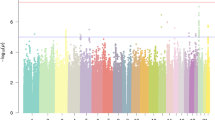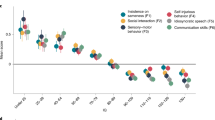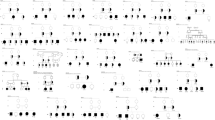Abstract
DYX1C1 was recently identified as a candidate gene for developmental dyslexia, which is characterized by an unexpected difficulty in learning to read and write despite adequate intelligence, motivation, and education. It will be important to clarify, whether the phenotype caused by DYX1C1 extends to other language-related or comorbid disorders. Impaired language development is one of the essential features in autism. Therefore, we analyzed the allelic distribution of the DYX1C1 gene by family-based association method in 100 Finnish autism families. No evidence for association was observed with any intragenic marker or with haplotypes constructed from alleles of several adjacent markers. No evidence for deviated allelic diversity was either observed: the frequency of expected dyslexia risk haplotype was comparable to its frequency in Finnish controls. Thus it seems unlikely that DYX1C1 gene would be involved in the genetic etiology of autism in Finnish patients.
Similar content being viewed by others
Introduction
Autism (MIM 209850) is a severe neurodevelopmental disorder beginning before the age of 3 years and characterized by severe social and communication impairments, repetitive and ritualistic behaviors, and a restricted pattern of interests.1 A strong genetic component has been established in autism by twin and family studies,2,3 but the numerous genome scans performed so far have failed to produce consistent linkage signals, as reviewed elsewhere.4 Delayed speech development represents one of the characteristic trait components of autism and has become an important focus of research in genetics of autism. Both qualitative5,6,7 and quantitative8 measures of language development have been used in attempts to improve the phenotypic homogeneity and, thus, to increase the power to identify susceptibility loci by linkage methods.
So far, only few genes have been linked to speech and language development. A monogenic severe speech and language disorder [MIM 602081] was originally mapped to 7q31 locus (SPCH1) in a large dominantly segregating KE family.9 The location of the disease-causing gene was refined by the identification of chromosomal breakpoint on 7q31 in an unrelated patient,10 and finally the causative gene was identified as FOXP2.11 FOXP2 is located on autism susceptibility locus 1 (AUTS1),12,13 but the sequence and association analyses have not supported its involvement in the etiology of autism.14,15,16 Noteworthy, also most samples with specific language impairment (SLI) have failed to show any linkage or association signals at the FOXP2 locus, indicating that it is unlikely to play a significant role in cases of typical SLI.14,17,18 However, one recent study showed putative evidence for association of FOXP2 locus with SLI.19 In a Finnish dyslexia sample, linkage for 7q31 overlapping SPCH1 and AUTS1 loci was observed, but sequencing of FOXP2 in dyslexic individuals revealed no coding sequence mutations.20
Developmental dyslexia (MIM 127700) is the most common childhood learning disorder characterized by an unexpected difficulty in learning to read and write despite adequate intelligence, motivation, and education.21 Recently, DYX1C1 was identified as the first candidate gene for dyslexia and the second gene associated with language-related phenoptype.22 DYX1 locus on 15q21 was originally identified by several independent research groups,23,24,25 and was further supported by the identification of a translocation t(2;15)(q11;q21), which segregated with the dyslexia phenotype in a Finnish family.26 A novel gene entitled as DYX1C1 was disrupted by the translocation, and subsequent analyses indicated that two DYX1C1 variants were positively associated with dyslexia. These were −3G>A, which is located on the binding site of several transcription factors, and 1249G>T leading to a premature stop codon and deletion of four amino acids at the 3′ end of the coding sequence. DYX1C1 protein is expressed in a subset of human glial and neuronal cells, but its precise function is yet unknown.22
It is important to clarify, whether the phenotype caused by DYX1C1 is restricted to developmental dyslexia only, or whether the association on DYX1 locus extends to other language-related or comorbid disorders. Here, we have tested association between the genetic variants of DYX1C1 and autism, in which severe impairment of speech and language development is one of the most characteristic features.
Subjects and methods
Family material
The autism families were recruited through a nationwide search of university central hospitals of Finland. A total of 100 families with 122 affected individuals were included in the study. Three families had three affected individuals, 16 families had two affected individuals, and 81 families were trios. Thorough clinical and medical examinations were performed by an experienced child neurologist or pediatrician,27 and the diagnoses were assessed according to ICD-1028 or DSM-IV criteria.1 Autism cases with associated medical conditions, such as fragile-X syndrome or chromosomal aberrations, were excluded. Only individuals with a confirmed diagnosis of infantile autism were included in the association analyses. In other words, family members with broad autism phenotype, such as Asperger syndrome, were assigned as unknown. A more detailed description of family recruitment, diagnostic instruments, and phenotypic assessment has been presented elsewhere.27
Genotyping
The DNA samples were genotyped using matrix-assisted laser desorption/ionization time-of-flight (MALDI-TOF) mass spectrometry (SEQUENOM Inc., San Diego, CA, USA).29 Four SNPs (−3G>A, rs3743204, 572G>A, and 1249G>T) were genotyped in a single multiplex reaction. PCR assays and associated extension reactions were designed using the SpectroDESIGNER software (Sequenom Inc., San Diego, CA, USA) and primers, for which the sequences are available on request, were obtained from Metabion GmbH (Planegg-Martinsried, Germany). All amplification reactions were run in the same conditions in a total volume of 5 μl with 2.5 ng of genomic DNA, 1 pmol of each amplification primer, 0.2 mM of each dNTP, 2.5 mM MgCl2 and 0.2 U of HotStarTaq DNA Polymerase (Qiagen). Reactions were heated at 95°C for 15 min, subjected to 45 cycles of amplification (20 s at 94°C, 30 s at 60°C, 30 s at 72°C) before a final extension of 7 min at 72°C. Extension reactions were conducted in a total volume of 9 μl using 5 pmol of allele-specific extension primer and the Mass EXTEND Reagents Kit before being cleaned using SpectroCLEANER (Sequenom Inc., San Diego, CA, USA) on a MULTIMEK 96 automated 96-channels robot (Beckman Coulter, Fullerton, CA, USA). Clean primer extension products were loaded onto a 384-elements chip with a nanoliter pipetting system (SpectroCHIP, SpectroJet, Sequenom) and analyzed by a MassARRAY mass spectrometer (Bruker Daltonik GmbH, Bremen, Germany). The resulting mass spectra were analyzed for peak identification using the SpectroTYPER RT 2.0 software (Sequenom). For each SNP, two independent scorers confirmed all genotypes.
Statistical analyses
The statistical analyses were performed using FBAT program (http://www.biostat.harvard.edu/~fbat/fbat.htm),30 which is capable of using information from both single markers and haplotypes constructed from the alleles of several adjacent markers. The empirical variance option was used, as appropriate in the presence of linkage and when data of multiple sibs in a family are available.31 The extent of linkage disequilibrium between SNPs at the DYX1C1 gene was tested using the tail probability (P-value) of Fisher's exact test implemented by Genepop 3.4 (http://wbiomed.curtin.edu.au/genepop/).
Results and discussion
DYX1C1 consists of 10 exons and encodes a 420 amino-acid protein with three tetratricopeptide repeat (TPR) domains. We genotyped four intragenic SNP markers flanking ∼68 kb in a set of 100 autism families with 122 affected family members: −3G>A located on 5'UTR (exon 2), rs3743204 in the second intron, 572G>A (G191E) in exon 5, and 1249G>T (E417X) in exon 10. SNPs were chosen on the basis of their previously shown association with risk of dyslexia in the Finnish population22 (−3G>A and 1249G>T) or because of reported frequency of about 30–50% in the population and use as control SNPs in our assays (572G>A with ∼50% and rs3743204 with 25–75% in NCBI database, http://www.ncbi.nlm.nih.gov/). We calculated the family-based association for each individual marker as well as for two-, three-, and four-marker haplotypes constructed from the genotypes of the adjacent markers. The analyses were restricted only to families with confirmed diagnoses of infantile autism to ascertain that all the patients assigned as affected had marked problems in language development and communication. Consistently with the original dyslexia study,22 all the patients were of Finnish origin. This type of study sample where families are collected from the isolated Finnish population should maximize genetic, environmental and diagnostic homogeneity of this complex trait.32
None of the tested associations yielded positive results as shown in Table 1. We also calculated the frequency of a two-marker haplotype of −3A/1249T shown to be positively associated with dyslexia. In the original report, 13% of cases with dyslexia were shown to carry this haplotype versus 5% of controls, yielding an odds ratio of 2.8 ([CI 95%]=1.2–6.5).22 The corresponding frequency of the expected risk haplotype in our family-based autism material was 3% both in the affected and in the founder individuals. We were not able to conduct a family-based association analysis of this haplotype because only one major allele was present in the autism families. Altogether, 17 out of 100 families in our study sample had at least one family member affected with developmental dysphasia (naffected=20), but this sample was not sufficient for association analysis. Significant LD (P< 0.001) was observed between all marker pairs, excluding markers rs3743204 and 572G>A. Consistently with the association data, we did not observe linkage evidence with the SNP markers analyzed here (data not shown) or with the flanking microsatellites analyzed in our previous genome scan.27
Based on our data, it seems unlikely that the DYX1C1 gene would have a major role in the etiology of autism in the Finnish families. It was earlier hypothesized that DYX1C1 might be involved in the broad spectrum of common childhood neuropsychiatric disorders involving learning and acquisition of specific competences.33 Autism is an extreme example of such disorder. On the other hand, autism is sometimes associated with extraordinarily advanced skills involving for example, special abilities in memory, mathematics or music. In some cases, autistic children display hyperlexic reading skills, and are able to identify printed words even at 18 months of age without instruction.34 This indicates that common, although opposite, physiological mechanisms might sometimes underlie behind dyslexia and autism.35 In future, it is important to analyze DYX1C1 also in other autism samples, as well as in disorders involving impaired speech and language development, especially in specific language impairment (SLI), and in comorbid disorders, such as attention-deficit hyperactivity disorder (ADHD).33
References
American Psychiatric Association: Diagnostic and Statistical Manual of Mental Disorders, 4th ed. Washington, DC: American Psychiatric Association, 1994.
Bolton P, Macdonald H, Pickles A et al: A case-control family history study of autism. J Child Psychol Psychiatry 1994; 35: 877–900.
Bailey A, Le Couteur A, Gottesman I et al: Autism as a strongly genetic disorder: evidence from a British twin study. Psychol Med 1995; 25: 63–77.
Veenstra-VanderWeele J, Cook EH : Molecular genetics of autism spectrum disorder. Mol Psychiatry 2004, Epub June 16.
Bradford Y, Haines J, Hutcheson H et al: Incorporating language phenotypes strengthens evidence of linkage to autism. Am J Med Genet 2001; 105: 539–547.
Buxbaum JD, Silverman JM, Smith CJ et al: Evidence for a susceptibility gene for autism on chromosome 2 and for genetic heterogeneity. Am J Hum Genet 2001; 68: 1514–1520.
Shao Y, Raiford KL, Wolpert CM et al: Phenotypic homogeneity provides increased support for linkage on chromosome 2 in autistic disorder. Am J Hum Genet 2002; 70: 1058–1061.
Alarcon M, Cantor RM, Liu J, Gilliam TC, Geschwind DH : Evidence for a language quantitative trait locus on chromosome 7q in multiplex autism families. Am J Hum Genet 2002; 70: 60–71.
Fisher SE, Vargha-Khadem F, Watkins KE, Monaco AP, Pembrey ME : Localisation of a gene implicated in a severe speech and language disorder. Nat Genet 1998; 18: 168–170.
Lai CS, Fisher SE, Hurst JA et al: The SPCH1 region on human 7q31: genomic characterization of the critical interval and localization of translocations associated with speech and language disorder. Am J Hum Genet 2000; 67: 357–368.
Lai CS, Fisher SE, Hurst JA, Vargha-Khadem F, Monaco AP : A forkhead-domain gene is mutated in a severe speech and language disorder. Nature 2001; 413: 519–523.
IMGSAC: A full genome screen for autism with evidence for linkage to a region on chromosome 7q. International Molecular Genetic Study of Autism Consortium. Hum Mol Genet 1998; 7: 571–578.
IMGSAC: Further characterization of the autism susceptibility locus AUTS1 on chromosome 7q. Hum Mol Genet 2001; 10: 973–982.
Newbury DF, Bonora E, Lamb JA et al: FOXP2 is not a major susceptibility gene for autism or specific language impairment. Am J Hum Genet 2002; 70: 1318–1327.
Wassink TH, Piven J, Vieland VJ et al: Evaluation of FOXP2 as an autism susceptibility gene. Am J Med Genet 2002; 114: 566–569.
Gauthier J, Joober R, Mottron L et al: Mutation screening of FOXP2 in individuals diagnosed with autistic disorder. Am J Med Genet 2003; 118A: 172–175.
Bartlett CW, Flax JF, Logue MW et al: A major susceptibility locus for specific language impairment is located on 13q21. Am J Hum Genet 2002; 71: 45–55.
SLI Consortium: A genomewide scan identifies two novel loci involved in specific language impairment. Am J Hum Genet 2002; 70: 384–398.
O'Brien EK, Zhang X, Nishimura C, Tomblin JB, Murray JC : Association of specific language impairment (SLI) to the region of 7q31. Am J Hum Genet 2003; 72: 1536–1543.
Kaminen N, Hannula-Jouppi K, Kestila M et al: A genome scan for developmental dyslexia confirms linkage to chromosome 2p11 and suggests a new locus on 7q32. J Med Genet 2003; 40: 340–345.
Shaywitz SE : Dyslexia. N Engl J Med 1998; 338: 30–312.
Taipale M, Kaminen N, Nopola-Hemmi J et al: A candidate gene for developmental dyslexia encodes a nuclear tetratricopeptide repeat domain protein dynamically regulated in brain. Proc Natl Acad Sci USA 2003; 100: 11553–11558.
Grigorenko EL, Wood FB, Meyer MS et al: Susceptibility loci for distinct components of developmental dyslexia on chromosomes 6 and 15. Am J Hum Genet 1997; 60: 27–39.
Schulte-Korne G, Grimm T, Nothen MM et al: Evidence for linkage of spelling disability to chromosome 15. Am J Hum Genet 1998; 63: 279–282.
Morris DW, Robinson L, Turic D et al: Family-based association mapping provides evidence for a gene for reading disability on chromosome 15q. Hum Mol Genet 2000; 9: 843–848.
Nopola-Hemmi J, Taipale M, Haltia T, Lehesjoki AE, Voutilainen A, Kere J : Two translocations of chromosome 15q associated with dyslexia. J Med Genet 2000; 37: 771–775.
Auranen M, Vanhala R, Varilo T et al: A genomewide screen for autism-spectrum disorders: evidence for a major susceptibility locus on chromosome 3q25-27. Am J Hum Genet 2002; 71: 777–790.
World Health Organization: International Classification of Diseases: 10 th Revision. Chapter V. Mental and Behavioural Diseases. Diagnostic Criteria for Research. Geneva, Author: 1993.
Jurinke C, van den Boom D, Cantor CR, Koster H : Automated genotyping using the DNA MassArray technology. Methods Mol Biol 2002; 187: 179–192.
Horvath S, Xu X, Laird NM : The family based association test method: strategies for studying general genotype–phenotype associations. Eur J Hum Genet 2001; 9: 301–306.
Lake SL, Blacker D, Laird NM : Family-based tests of association in the presence of linkage. Am J Hum Genet 2000; 67: 1515–1525.
Peltonen L, Palotie A, Lange K : Use of population isolates for mapping complex traits. Nat Rev Genet 2000; 1: 182–190.
Grigorenko EL : The first candidate gene for dyslexia: turning the page of a new chapter of research. Proc Natl Acad Sci USA 2003; 100: 11190–11192.
Grigorenko EL, Klin A, Pauls DL, Senft R, Hooper C, Volkmar F : A descriptive study of hyperlexia in a clinically referred sample of children with developmental delays. J Autism Dev Disord 2002; 32: 3–12.
Turkeltaub PE, Flowers DL, Verbalis A, Miranda M, Gareau L, Eden GF : The neural basis of hyperlexic reading. An FMRI case study. Neuron 2004; 41: 11–25.
Acknowledgements
We thank all the individuals who participated in this study. This study was financially supported by Päivikki and Sakari Sohlberg Foundation, Sigrid Juselius Foundation and the Center of Excellence in Disease Genetics of the Academy of Finland. TY and KR are supported by Biomedicum Helsinki Foundation. CML is supported by the Royal Physiographic Society and the Swedish Medical Research Council. JK is supported by the Swedish Research Council, and by a grant from Pharmacia/Pfizer for research of dyslexia. LP is a holder of the Gordon and Virginia MacDonald Distinguished Chair in Human Genetics at UCLA, endowed by the MacDonald Foundation.
Author information
Authors and Affiliations
Corresponding author
Rights and permissions
About this article
Cite this article
Ylisaukko-oja, T., Peyrard-Janvid, M., Lindgren, C. et al. Family-based association study of DYX1C1 variants in autism. Eur J Hum Genet 13, 127–130 (2005). https://doi.org/10.1038/sj.ejhg.5201272
Received:
Revised:
Accepted:
Published:
Issue Date:
DOI: https://doi.org/10.1038/sj.ejhg.5201272
Keywords
This article is cited by
-
Investigation of Dyslexia and SLI Risk Variants in Reading- and Language-Impaired Subjects
Behavior Genetics (2011)
-
Genetics of developmental dyslexia
European Child & Adolescent Psychiatry (2010)
-
Evaluation of STOX1 as a preeclampsia candidate gene in a population-wide sample
European Journal of Human Genetics (2007)
-
Developmental dyslexia: an update
Journal of Human Genetics (2007)
-
Speech Sound Disorder Influenced by a Locus in 15q14 Region
Behavior Genetics (2006)



